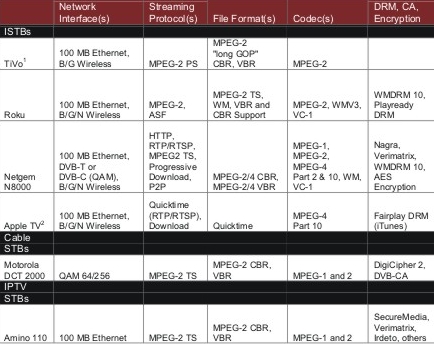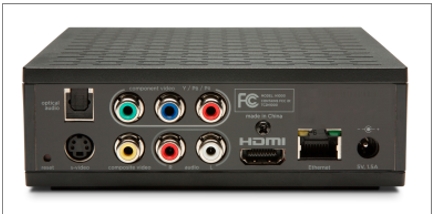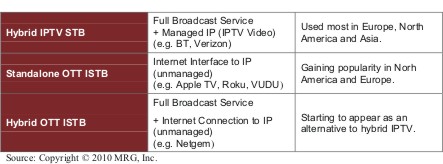|
 |
|
Internet TV Set-top Boxes allow viewers to watch streaming media from the Internet on standard television sets. Internet TV STBs (often called I-STBs) may be dedicated Internet TV STBs or they may provide functions that are added to other media processing devices such as gaming consoles, Blu-ray players or even TV sets. (Note: Internet TV is also known as Internet Video or Over-the-Top (OTT) service.)
I-STBs may be designed or programmed to work with Internet TV Broadcasters or they may allow the users to directly connect to the media source (such as an Internet streaming channel directly from a TV Broadcaster).
I-STBs can have a mix of network connection options, output connection types, operating systems, media processing types, and protocols. |
The choice of specific I-STBs can determine which service can be provided to the viewer and how efficient the system can operate.
One of the main things to keep in mind is that I-STBs need to be as inexpensive as possible. Back when algorithms for encoding and decoding video were being looked at, it was decided that the algorithm needed to be asymmetrical meaning that the encoders should be more complex and costly because there are much fewer of them and decoders needed to be simple and inexpensive as there are a lot of them. So MPEG, or more precisely the Discrete Cosine Transform (DCT), was chosen for these reasons. Other algorithms such as Wavelets (JPEG 2000) are more symmetrical and are not a good choice for consumer video applications. |
|
 |
| Figure 1: HDTV: Rear Panel Connections Simple OTT/IPTV Installation |
|
|
|
Some I-STBs are fairly closed systems such as Roku and TiVo, so these are fairly simple to control from a development and cost stand point. Some of the newer ones such as the Boxee box and the I-STB from Triveni Multimedia are more open and have more challenges in both of these areas. The advantage for the more open I-STBs is that the customer is not confined to a "walled garden." The consumer can do quite a bit more.
Network Connections
I-STBs commonly have a wired Ethernet (RJ-45) and/or Wi-Fi for the Broadband connection. Some I-STBs combine other types of network connections such as DTT Broadcast TV, Cable TV (RF inputs) or Satellite (also an RF input).
Wired Ethernet connections are fairly simple these days and have |
very little impact on the STB itself. Wi-Fi wireless components are a bit more complex, especially those used for streaming video. One of the more popular chip manufacturers is Atheros. Its products offer a number of the 802.11 extensions, as well as QoS. These become necessary if you have 2 or more video streams at the same time or if you have other applications such as VoIP in addition to normal Internet activity.
The combination or hybrid STBs include interfaces that allow you to add a traditional service along with an Internet service. This can be combined into one service such as with the TiVo Series 2 or 3 products so there is one interface and you don't have to switch back and forth on your TV set inputs.
Figure 2 shows a comparison of I-STBs, IPTV STBs and Cable STBs. When I-STBs first came out they were not nearly as capable as |
 |
| Figure 2: Internet STBs Compared with IPTV and Cable STBs |
|
|
|

|
|
Figure 3: Rear View of the Roku HD STB Source: Roku
|
|
they are today. Many of them come close to conventional STBs. In the case of Netgem's I-STB, it is actually the same product with certain features enabled or disabled.
Output Connections
The outputs of I-STBs typically include
composite video (RCA), stereo audio (RCA), and S-Video. Some also include component video, · HDMI, and optical audio. These can be PAL or NTSC depending on the country.
Figure 3 shows the rear connections on the Roku HD STB. (Roku also offers an SD only model that it less expensive.)
Some models have a USB connection which can be used for external storage or for an external Wi-Fi adaptor.
Operating System
The I-STB operating system and its available drivers coordinate the overall operation of the device. Some of the available operating systems for I-STBs include Linux, Windows, and Android.
Interface applications (clients) are installed into the STBs to provide a user interface (navigation and programming guide), middleware access (media mapping), access control (conditional access), and content protection (copy protection or encryption). |
Media Decompression
One of the main functions of the I-STB is to decode the streaming media (video, audio, images and other data). The media decompression may be performed by special chips (codecs) or it may be performed by software programs that are used by a general microprocessor. When a STB can perform processing in a dedicated codec chip, the decoding process may be faster and reduce the burden of processing on the system microprocessor, but the range of decoding options is reduced to whatever the chip supports. As time goes by and defacto standards emerge it is expected that all STBs will use dedicated chips such as those from Broadcom, ST Micro or NEP.
There are several types of media compression that may be used in Internet TV systems. In general, the higher the compression ratio (lower bandwidth required), the more processing is required by the STB. Some of the common types of compressed video include MPEG-2, MPEG-4, Flash and Windows Media Video (VC-1). Some of the common types of compressed audio include MP2, MP3 and
AAC.
MPEG has different profiles and levels that determine the decoding and presentation abilities, but only a few are used for Internet Video. The main differences are with the choice of resolutions and aspect ratios. Right now the main drive is to be able to deliver a resolution of 1080p with a 16:9 aspect ratio so people with HDTV sets will not be disappointed. |
|
|
|
 |
| Figure 4: IPTV vs. OTT STBs |
|
Internet Video/OTT is produced either with a single stream or with multiple streams. In the case where there is a single stream, the job of the STB is very simple. In cases where there are multiple streams, the STB communicates with the server to determine which stream, based on how much bandwidth is available, to decode. Most of the intelligence is at the server. There is a client on the STB that monitors the buffer and looks for underflow or overflow. This information is fed back to the server which then decides which of the stream rates the network can handle.
The lowest data rates are typically around 700 Kbps which are perfectly fine for an SD TV set and possibly for a small HDTV, but for larger HDTV sets the necessary data rates can be as high as 4 Mbps. In this case, the consumer must have a very high-speed Broadband service.
Processing Capability
When developing an I-STB two of the main considerations are processing power and memory. If it is using a software decoder then the majority of the processor is used for decoding video and this can vary quite a bit from the previous section. This is another reason why dedicated chips are preferred by STB manufacturers.
To give you a better idea here are some scenarios:
SD video at 700Kbps could be achieved on an x86 with something like a 500MHz Celeron processor. It may be possible to squeeze as much as 25% more performance with fine tuning of the software decoder to the CPU and other network and system software customizations. |
An ARM processor will require almost 1GHz and a MIPS processor around 800MHz.
By comparison an I-STB with a dedicated video decoder chip would be able to get by with as little as 200MHz ARM CPU.
HD video at 2-4 Mbps would require a 2GHz CPUx86 at least with some support from a graphics card.
Protocols
STBs use protocols to send and process commands and to provide vital information to other components, primarily the streaming server.
Protocols usually have multiple versions and later versions commonly add capabilities.
Control
Control protocols are used to setup and manage the operation of the STB device. The most common protocol used for video streaming is RTSP. RTSP is used to set up the video session and provides for "trick-play" functions. Trick-play functions are; Pause, Rewind and Fast-forward. An SNMP agent might be included for network maintenance and control, but this is uncommon.
For Internet connection management these are primarily in the Ethernet and Wi-Fi components and don't impact the other portions of the I-STB, but are important for establishing and maintaining network connectivity. |
| |
|
The multicast control protocol (IGMP) is used by IPTV STBs as the Broadcast streams are multicast on a managed video network, but are not used yet in Internet applications. First, in the Internet space everything is assumed to be on-demand, for now at least. This will change as more and more "live" streams are deployed. Most ISPs block multicast traffic so this will require the cooperation of them to enable this.
Internet STBS do use a CA/DRM client to authenticate the user and to decide what content the user is entitled to.
Storage
Memory considerations are looked at in two areas: RAM/Flash memory and whether or not to include a hard drive.
RAM/Flash Memory
RAM/Flash memory depends on the number of clients needed (see protocol section) and what is needed to assist in decoding. RAM memory can be a big help with buffer overflow especially in cases where there isn't a hard drive in the STB. The operating system is typically held in RAM memory.
Disk Memory-Hard Drives
Disk memory (such as a hard disk drive) may be included to store programs and other media (such as downloaded ads), but are commonly used for downloading video and providing PVR functions.
Remote Control Devices
Just like other video devices IR remote controls are very common. Blue Tooth (commonly used for wireless mice and keyboards) tends to be a limiting choice as the average U.S. living room is big enough to be out of range of these devices. If the STB is in a different room, then RF is used. For the fancy gyro-based products, like those from
|
Logitech and Hillcrest, RF is used as they cannot guarantee line-of-site.
I-STBs have come a long way and are getting better and better. Consumers will certainly have a lot to choose from.
Conclusion
The I-STB is part of the rise of OTT (Internet Video) that MRG started tracking in 1999 with the growth of CDNs. As an 11-year old market sector, OTT, with the assistance of standalone and embedded I-STBs, will continue to offer consumers, content owners and service providers ever new opportunities to access and distribute high quality and high value content to TV sets around the world. |
|
For more information on MRG's OTT and Hybrid STB reports, see:
www.mrgco.com/iptv/ott09.html
www.mrgco.com/iptv/hstb09.html |

Mike Galli, MRG Analyst, has over 20 years experience in the video industry. He has worked in engineering, marketing and sales positions at The Grass Valley Group, VXtreme (acquired by Microsoft), DIVA, Minerva and Kasenna (acquired by Espial). Mike has a BSEE degree from the University of California, Berkeley. |
|

|
|
|
|